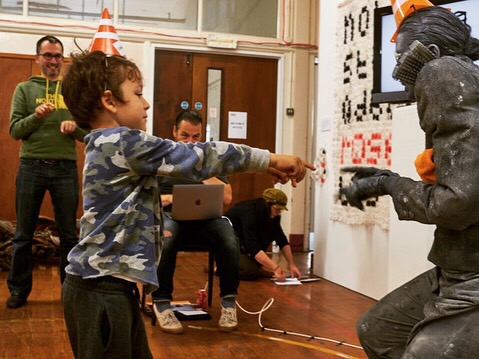
Bursary schedule
The aim of my proposed bursary activity was to research and develop making my work accessible to children by integrating Makaton language to communicate signs within the work. There were some changes to my original schedule due to gaining some knowledge of Makaton and learning the early stages of dance movement shortly after submitting my application for the bursary. I intended to work with choreographer Kevin Turner however, due to his work commitments and the development of my dance vocabulary this mentoring wasn’t essential to realising my original proposed activity. I found using Skype technology a much more cost-effective way of working 1-2-1 with Helen Adams, Makaton Trainer to maximize my time with her. Through a combination of Skype and email correspondence, I had bespoke Makaton sign and symbol support which was essential to interpreting my performance and workshop. Learning Makaton is a life long practice and I felt that I was ready to step up a level and used the remainder of the funds to complete the 3 day Makaton Enhancement course in July.

Go see
As part of my weekly practice, I have been researching online videos of Mr Tumble which I found incredibly important to see how to deliver information using Makaton in a fun, clear way without overloading the audience with too many words. The actor Justin Fletcher plays two characters and I found this really useful to see how he changed his rhythm of delivery in particular when giving more information and how he used mime, pointing and directional movement when he plays the clown character with only the key signs used. This gave me a good guide and a way of changing my delivery when being the host and being a performing statue.
I wanted to go and see a Makaton signed theatre show in the North West however there wasn’t anything available, in fact, I could only find two shows in the UK mainly touring in London. I went to see Ribbet Ribbet Croak Croak by Moulded Theatre at the Cockpit and was lucky enough to meet the director before the show. The production was fully signed by two performers and was over an hour-long which I felt for families with young children and neurodiverse audiences was too long. This re-affirmed for me the advantage of shorter pop up events. The use of supporting symbols where minimal in comparison to the fully signed narrative and I could see missed opportunities of spreading the word of Makaton through distributed marketing and learning material for the audience.
R&D showing & creative evaluation
To test out the now retitled ‘Statue’ performance and workshop with Makaton I was selected to present my work at Haphazard, live art event for families at Z-arts in Manchester shortly after receiving the bursary which meant that I went into an intense period of research working with Helen Adams, Makaton Tutor. I learned Makaton through interpreting with Helen the content of the micro performance, workshop and overall hosting of the activity signing the keywords throughout supported by the words and symbols to make it as inclusive as possible for children. Being a statue offered more creative interpretation when signing by holding the end sign position until the next keyword that presented clear communication whilst holding body shapes making this performance and workshop unique, creative and fun.

I worked with filmmaker Sophie Broadgate who documented Statue at Haphazard which I have reflected on to identify any areas of development which were the speed of delivery and emphasising that with Makaton you speak and sign at the same time which is a distinct difference to BSL. To gain feedback from the audience an interviewer spoke to 10 families to find out what they liked and what could be developed further. Generally, the feedback was very positive and the only development was the timings of the event that needed to be slightly shorter which I have adapted. The space rocket image which is the Makaton symbol for the word was a huge success and really captured the children’s imagination with the songs sound effects whilst linking it to the word.

Through my training, I have learned the importance of presenting Makaton supported work to everyone which means engaging children and their families is an important part of continuing learning after the event. People like to learn in different ways and alongside the signing, I created a symbol and word slideshow which mirrored my signing to the song ‘Digital Love’, Daft Punk. This work was supported by Arts Council England, although the first draft stages of this symbol translation were made possible through my work with Helen Adams, a-n Artist Bursary.

Impact on practice
This bursary has had a significant impact on my practice and funded specialised training and going to see a Makaton signed theatre show outside of the North West. I have quickly reached a competent standard in Makaton signing and I submitted an application to the Makaton Charity to go for Makaton Friendly status which I can proudly say that I have achieved and I am now a Makaton Friendly Performance Artist. With gaining interest in my work and building confidence in myself I felt it was the right time to go for additional support and applied to Arts Council England to continue this work and I was successful at achieving a Project Grant. I would not have been able to apply for this without the confirmed support from the a-n Artist Bursary. I am excited about the future of my practice and will be touring this work to the Orchards Specialist School in Trafford later this year.






















